|
Introduction
This is Part 2 of a white paper series which provides an overview of the latest automation technologies available for high volume full pallet distribution storage and retrieval operations such as in the Fast-Moving Consumer Goods (FMCG) industry. Highly effective automation technologies are available from global material handling vendors and our expectation is that these technologies will increasingly be deployed on North American soil. Part 1 (click here) and Part 3 (click here) discuss the latest technologies for horizontal pallet transfer systems, pallet sortation and automated truck loading systems.
Part 1 (click here) of this white paper will review the concepts listed below:
- Pallet Transfer Solutions (Production to Storage)
- Vertical Pallet Transfer Solutions
- Horizontal Pallet Conveyors
- Overhead Monorail Systems
- Inverted Monorail Systems
- Automated / Laser Guided Vehicles
Part 2 of this white paper reviews the concepts listed below:
- High Bay Warehouse Automated Storage and Retrieval Systems (ASRS)
- Single-Mast Single-Pallet ASRS
- Single-Mast Dual-Pallet ASRS
- Aisle-Changing ASRS
- Dual-Mast Dual-Pallet ASRS
- ASRS with Satellite Carrier
- Shuttle Cart Technology
Part 3 (click here) of this white paper reviews the concepts listed below:
- Shipping Solutions
- Inverted Monorail
- Overhead Monorail
- Conveyor Systems with Transfer Cars
- Automated Truck Loading Systems
- AGVs
- ATLS
PART 2: Pallet Storage Solutions (High Bay Warehouse and Storage/Retrieval Machines)
Automated storage and retrieval systems (ASRS or AS/RS) are rail-guided vertical-mast crane machines that are designed to automatically store and retrieve unit loads (e.g. pallets) into high bay warehouses without human intervention. According to our research, this technology was first invented in the late 1960’s. The first cranes that were deployed in the field were much slower than the equipment available on the market today. Many of the early cranes moved in the range of 10 pallets per hour in and out of storage and today this rate has been significantly increased as will be discussed in the body of this paper. Not all AS/RS systems are the same so it is important to understand the different types of technologies that can be considered when designing an automated high bay warehouse facility.
1. Single-Mast Single-Pallet AS/RS
This is the most common type of automated storage and retrieval machine deployed in the market to this day for no other reason than this type of AS/RS was the first to be invented and therefore has been around the longest.
- In North America, the typical heavy duty single-mast single-pallet AS/RS machine is designed to handle unit loads weighing upwards of 4,000 Lbs (1814 KG) with lift height requirements of up to 110’ (33.5m) in height. Having said this, there really is not such a thing as a “typical” AS/RS crane and it is important to understand that these machines are engineered to handle the specific needs of each operation. For example, in the beverage industry, finished goods pallets can weigh 2,500 LBs (1,134 KG) and there are multiple ASRS cranes that exist to handle this unit load weight requirement. In fact, there are cranes that can handle well over 7,700 LB (3,493 KG) loads.
- In Europe, land is less available so AS/RS cranes are generally designed to lift unit loads higher as a result of market demand for these solutions. European AS/RS cranes can store pallets to clear heights of up to 41m - 50m (135’ - 165’) which is roughly 13 - 17 pallet levels high depending on the height of the pallet.
- When traveling empty, a single-mast AS/RS machine can achieve horizontal speeds in excess of 240 m/min (787 FPM) and vertical speeds of up to 90 m/min (295 FPM). Travel speeds, acceleration rates (equally important), and unit load weight restrictions vary by manufacturer so it is not safe to assume that the speeds discussed in this article are industry standards. Clearly speed is an important consideration as it ultimately determines the throughput capacity of the crane but there are many other important considerations as well.
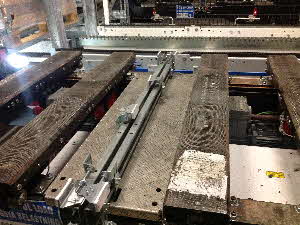
- Single-mast AS/RS machines can be equipped with telescopic forks that store pallets in single deep, double deep, triple deep, and even 4-deep static racking environments.
- Keep in mind that the maximum pallet weight that a crane can handle will typically decrease as the rack depth increases from single deep to four-deep storage because the weight of the unit load is being extended further away from the mast of the crane.
- For example, the same crane that can store a 4,000 LB (1,814 KG) pallet in a single deep environment would be limited to storing a 2,500 LB (1,134 KG) pallet in a 2-deep environment; and an 1,800 LB (816 KG) pallet in a 3-deep environment.
- ASRS machines can be equipped with different load handling devices to move pallets into/from the st
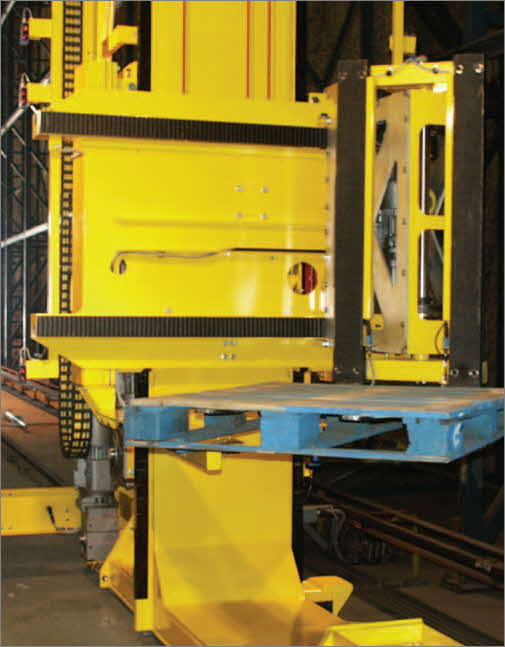 orage location. A common approach is to equip the crane with a telescope shuttle table (1, 2, 3, 4-deep) that picks up pallets from below. The telescopic shuttle extends into the storage location (up to 4 pallets deep) and lowers the pallet to its final resting place. There are variations of telescopic shuttle tables and telescopic forks that need to be clearly understood as there are pros and cons depending on the application. orage location. A common approach is to equip the crane with a telescope shuttle table (1, 2, 3, 4-deep) that picks up pallets from below. The telescopic shuttle extends into the storage location (up to 4 pallets deep) and lowers the pallet to its final resting place. There are variations of telescopic shuttle tables and telescopic forks that need to be clearly understood as there are pros and cons depending on the application.
- AS/RS machines can also be equipped with turret forks designed to store and retrieve pallets from both sides of the aisle for storage environments of up to 60’ (18.2m). These cranes are capable of working in single deep, push-back rack environments (2 and 3-deep). Generally speaking, this type of crane is a slower machine that runs at horizontal speeds of 350 FPM (107 m/min) and vertical speeds of up to 58 FPM (18m/min). This type of ASRS machine is sometimes used by distribution operations where full case pick slots need to be replenished from overhead reserve slots.
2. Single-Mast Dual-Pallet AS/RS
- Single-mast storage and retrieval machines can move dual pallets (i.e. pallet pairs) with pallet weights of approximately 2,200 LB (1000 KG) per pallet (weight capacities vary by manufacturer).
- When fully loaded with two pallets, horizontal travel speeds for these machines are generally in the range of 240 m/min (787 FPM) and vertical travel speeds are in the range of 90 m/min (295 FPM) .
- This type of crane is often used in environments where pallet sizes are standard and throughput rate requirements are high. Companies sometimes use this type of crane in warehousing environments where there is a high variety of SKUs that need to be stored such that it is important to move pallets two at a time, but it is not always feasible to move pallet pairs of the same SKU with each trip.
- The benefit of using a single-mast crane versus a double-mast crane is that the storage and retrieval machine weighs less therefore less energy is required to move the crane and ultimately this saves money in energy costs over the long term. The single-mast crane is also less expensive to produce and is generally faster and more dynamic in terms of performance.
3. Aisle-Changing ASRS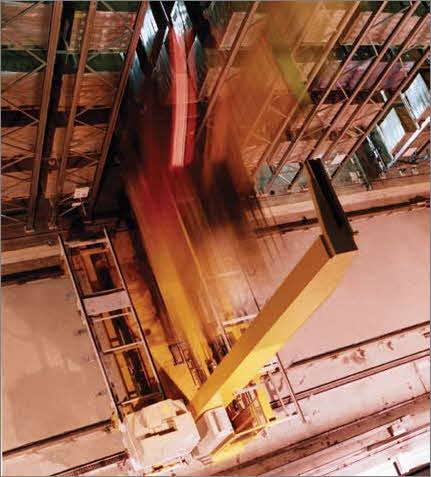
- Unlike captive-aisle storage and retrieval machines, the aisle-changing ASRS is designed to automatically service more than one aisle just as the name would suggest.
- The benefit of this type of storage and retrieval machine is that it enables a company to deploy an ASRS system with a lower initial capital investment, because each crane can service multiple aisles in the high bay warehouse. The disadvantage is that additional floor space (typically 18 feet or 5.5m) is needed to provide a rear run-out cross-aisle to allow the crane to move out of one storage aisle and into another.
- Also, the aisle-changing process takes time and this reduces the effective throughput capacity of the crane, thus this type of application is generally used in warehouse environments where there is a slower throughput requirement. For example, in the FMCG industry this type of storage and retrieval system can be used for handling pallets of returnables that are stored in a separate designated room within the facility.
4. Dual-Mast Dual-Pallet ASRS
- Dual-mast cranes are designed with two vertical masts that are tied together at the top and bottom of the crane with a cross-member. These cranes were originally designed for the beverage industry where: pallets are heavy; production output volumes are extremely high; and many pallets of the same SKU are produced on the filling lines. These cranes are designed to efficiently move pallet pairs of the same SKU to double up the throughput capacity of the conventional single-mast single-pallet crane.
- This type of machine is designed to move pallets in pairs at the highest possible speeds. Fully loaded horizontal travel speeds vary but can go up to 240 m/min (787 FPM) and 60 m/min (197 FPM) for vertical lift speeds.
- Single-depth or double-depth telescopic forks can be used to store pallet pairs 2-wide into single deep racking systems; or 2-deep into 2-deep racking systems. The decision is really one that needs to be determined for each high bay warehouse and is based on the variety, movement and inventory profiles of the SKUs that need to be stored and retrieved.
- Depending on the length of the high bay warehouse, these machines can achieve pallet throughput rates exceeding 75 pallets per hour and are best suited to warehousing environments that require robust high throughput capacity.
- Dual-mast dual-pallet cranes are heavier because of the double mast therefore they generally are deployed where the weight or shape characteristics of the unit loads requires the additional stability of the double mast. When very heavy loads need to be lifted to extreme heights, it is critical to minimize the sway or flex of the mast hence the need for the additional rigidity provided by the double mast. An unloaded dual-mast ASRS machine weighs approximately 27,000 KG (59,500 LB) so this is an exceptionally heavy crane that consumes significant energy to accelerate. Regenerative braking is an important feature to consider as it enables some of the energy that is consumed for acceleration to be applied for braking / deceleration.
5. AS/RS With a Satellite /Shuttle /Mole/ Carrier
- These storage and retrieval machines can be either single or dual pallet cranes depending on the throughput requirements. In this scenario, the ASRS machine is equipped with a satellite carrier that is designed to depart from the ASRS crane such that pallets are transported into multi-deep storage lanes that are sometimes referred to as storage channels.
- At designated stations, pallets are picked up as single loads (or dual tandem loads) for transport to an assigned storage lane within the high bay warehouse. Storage lanes are typically in the range of 4 - 8 pallets deep and are essentially multiple-deep static racks. The satellite carrier rides on board the crane and is used to perform the actual storage and retrieval function within the storage lane. When the crane positions itself in front of the storage lane, the satellite carrier then departs from the crane and drives into the storage channel to store or retrieve a pallet. The pallet sits on top of the carrier and the carrier drives into rail channels that are set up in each of the storage lanes. The carrier elevates the pallet during motion and then lowers the pallet onto supporting rack beams when it has reached its storage location within the storage lane.
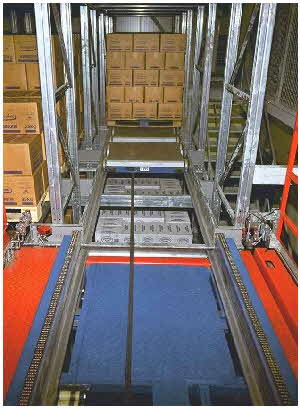
- Different vendors use different approaches to power the satellite carrier. For example, the shuttle carrier can be powered by a shielded umbilical cord so that no electronics are on board the carrier. In this case, a cable reel drum on the crane mast unwinds the power cord as the carrier drives into the lane. Similarly, the power cord is retracted as the carrier returns to the crane. Alternatively, the shuttle carrier can be equipped with a battery or energy cell that is recharged as soon as the carrier returns to the crane’s docking station. Bus bars can also be used to transmit power to the carrier. Regardless of the approach, the satellite carrier will be the slowest performing component of the crane system with horizontal speeds typically in the range of 60 m/min (197 FPM).
- This type of crane is typically deployed in a high bay warehouse environment where there is a low to medium SKU variety and high inventory levels of pallets for each SKU. For example, it there are finished goods SKUs that have hundreds of pallets in inventory then this is a good fit. If the typical SKU has 2 - 3 pallets in inventory then this is not a good fit. In the food and beverage manufacturing industry, this is a common application because many pallets of the same item are produced on a production line which allows the storage lanes to be filled up without mixing production lots.
- Westfalia has come up with a unique concept whereby each crane aisle can support the concurrent use of one or two ASRS machines equipped with satellite carriers. This is accomplished by having each ASRS machine service a dedicated zone of rack bays within the operating aisle. For example, if two cranes work in the same aisle then one crane manages all storage and retrieval tasks for the front half of the aisle, and another crane works the back half of the aisle. This concept is enabled by running pallet conveyors through the racking system such that pallets are brought to multiple stations so that each crane can pick up and drop off unit loads at its own station. The benefit of this approach is that the throughput capacity of the operating aisle is effectively doubled, and is not constrained to the capacity of a single machine. In fact throughput rates are more than doubled because each crane only travels 50% of the horizontal distance within an aisle which reduces total distance traveled versus having one machine per aisle. Depending on the application, the ability to input and output more than 100 pallets/hour/aisle is enabled. However it is important to note that this concept requires the extensive use of pallet conveyor to navigate pallets into and out of the high bay warehouse so this must be taken into consideration when evaluating the pros and cons of this type of solution.
6. Automated High Density Pallet Shuttle Cart Systems
- This is a relatively new and interesting material handling concept being used to automate the storage and retrieval of pallets within a high bay warehouse. The shuttle cart system effectively eliminate
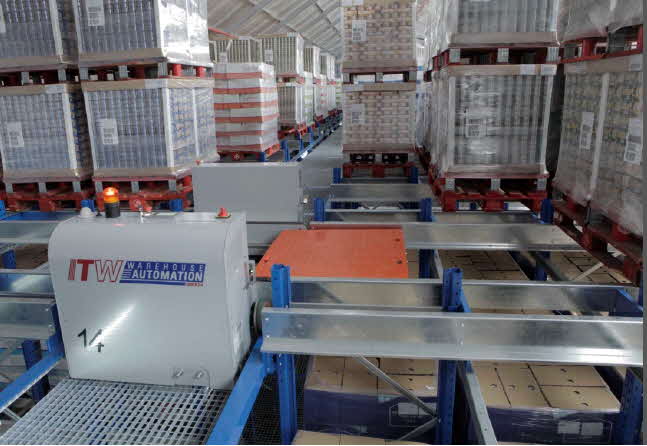 s the need for ASRS cranes. s the need for ASRS cranes.
- With this concept, pallets are brought to the high bay warehouse via some type of horizontal transfer system (e.g. pallet conveyor, inverted monorail, overhead monorail, etc.). Pallets are then transferred to vertical elevators that lift the unit loads to the assigned vertical storage level where the pallet is to be stored. Each storage level (or row) is equipped with a dedicated master shuttle cart that then transfers the pallet to its assigned storage lane. Once the master cart arrives at the lane, a child cart then departs the parent cart and transfers the pallet into the storage lane which is typically 4 - 8 pallets deep.
- The fact that each operating aisle and each storage level has a dedicated shuttle cart allows for potentially higher throughput volumes than can be achieved with en equivalent crane system. In effect the bottleneck to the high bay warehouse becomes the elevators which need to vertically transfer pallets to the assigned storage levels. To avoid this bottleneck, the use of tandem pallet elevators becomes important such that two pallets are always lifted or dropped with each trip.
- The main shuttle cart that runs within each level of the operating aisle is powered by a bus bar that runs inside the channel that the cart runs along. The parent cart can travel at horizontal speeds of up 240 m/min (787 FPM) which allows it to move unit loads at a rate of up to 40 pallets in and out per hour.
- The child shuttle cart that drives pallets into the storage lanes is powered by a battery that is recharged every time that it returns to the “belly” of the parent cart. One of the potential issues with this type of solution is the 1000 KG (2,200 LB) weight capacity constraint of the child cart which may not be sufficient for all products. For example in the beverage industry, finished goods pallets often weigh upwards of 1,134 KG (2,500 LB). The child cart travels at a horizontal speed of about 36 m/min (118 FPM) and is the slowest component of the overall system.
- This type of solution is suited to warehousing environments where there is a high throughput volume for products that have relatively high levels of inventory. The system is really designed around the notion of multi-deep storage lanes which implies that SKUs need to have enough inventory to fill the storage lanes. For production facilities that produce many pallets of the same SKU with each production run, it is an excellent fit.
This concludes Part 2 of our white paper on automation for distribution in the food and beverage industry. For more a detailed presentation on this subject click Here. Part 1 (click here) and Part 3 (click here) discuss the latest technologies for horizontal pallet transfer systems, pallet sortation and automated truck loading systems.
Marc Wulfraat is the President of MWPVL International Inc. He can be reached at (1) (514) 482-3572 Extension 100 or by clicking here. MWPVL International designs automated distribution centers and automated material handling systems and can help your firm evaluate the most appropriate solutions for your manufacturing or distribution operation.

|